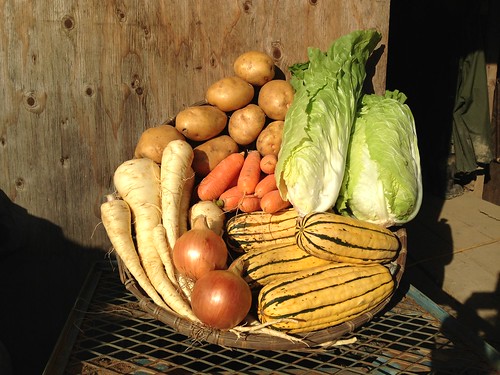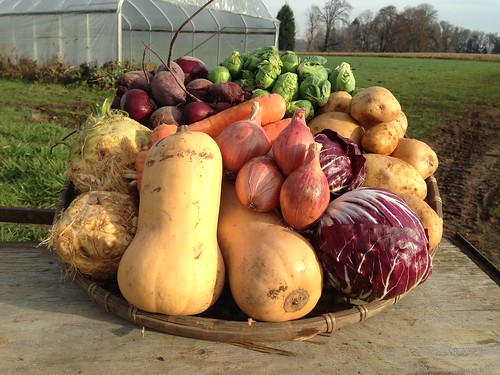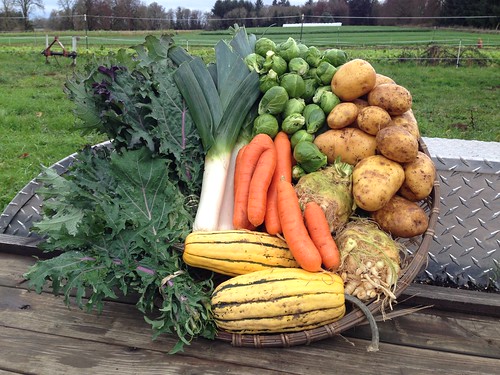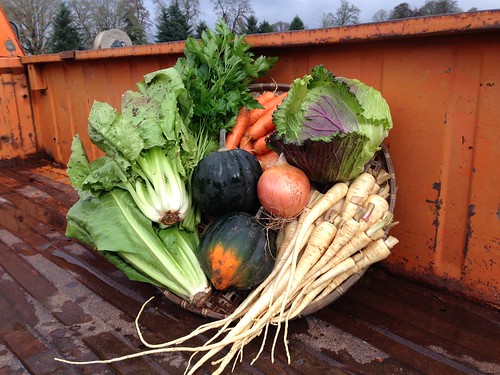I’ve tried to minimize the stove time in the recipes this week as it’s going to be a hot week! And squash is here! I know they are prolific and we’ll be seeing them for months but I really don’t tire of them. I harvested my first one out of the garden today. Happy Cooking and stay cool!
Salad of Fava Beans, Fennel and Mint
Green Salad with Fava Beans, Crab and Basil and Aioli Dressing
Beet Basics: Roasted, Boiled and Grated/Marinated
Beets and their Greens with Garlicky Yogurt
Kale Salad with Toasted Sunflower Seeds
Summer Squash Frittata
Zucchini in the Frying Pan
Grilled Fennel
Salad of Fava Beans, Fennel and Mint
Fresh and delicious and perfect for this hot week.
Serves 3-4
1 ½ -2 cups shelled fava beans
1 ½-2 cups very thinly sliced fennel
A little olive oil
4 cups washed, dried lettuce torn into bite-sized pieces
Handful of mint leaves
2-3 ounces aged pecorino or Parmesan, shaved with a vegetable peeler into thin shavings
For the dressing:
Juice of one lemon
Salt and freshly ground pepper
About 4 tablespoons of the best olive oil you have
About a teaspoon of balsamic vinegar
Bring a pan of salted water to a boil. Add the shelled fava beans and cook for about 4 minutes (if they’re really small cook for more like 2 minutes). Remove them with a slotted spoon and run under cold water. Shell the individual fava beans.
Whisk together the dressing ingredients. Toast the slices of bread and tear them into small bits and drizzle with a little olive oil and sprinkle with a little salt.
Now toss the lettuce and mint with the dressing, then add the fennel and fava beans and the cheese and the bits of bread and toss again.
Green Salad with Fava Beans, Crab and Basil and Aioli Dressing
I put this salad together on a whim after I splurged on a beautiful Dungeness crab at the farmers’ market. I had both fava beans and shelling peas but just fava beans will be fabulous too. And you could substitute canned Oregon Albacore for the crab or bay shrimp or omit entirely or add chopped hardboiled egg or no additional protein at all. Adapt to your tastes/what you have on hand.
Serves 4-6
About 6 ounces of crab meat (I got that from one whole crab-albeit a very large one) (see headnote)
1 ½ – 2 cups shelled fava beans
½ cup shelled peas (optional—see headnote)
6 cups lettuce, washed, dried and torn or chopped
Handful of basil leaves, thinly sliced or torn
2 scallions, thinly sliced (or a bit of any other type of onion)
2-3 tablespoons aioli or store bought mayonnaise you’ve doctored with some minced garlic, lemon juice, salt, a little Dijon and a bit of olive oil.
Juice of half a lemon or more to taste
Salt and freshly ground pepper
Shell the fava beans and cook the beans in salted boiling water for 3-4 minutes. Drain and rinse in cold water. Pinch the skins of the beans and set aside. If using shelling peas, cook those for 2 or so minutes in the same water as you used for the favas.
In a small bowl mix the crab, beans (and peas if using) with 1 1/2 tablespoons of aioli and a little salt and pepper.
Toss the basil, scallions and lettuce in a large bowl or on a platter with the remainder of the aioli or doctored mayonnaise and the lemon juice. If your aioli or mayo is too thick for tossing thin it with a little cream or water. Taste and adjust seasoning. Spread the fava bean crab mixture on the bed of greens.
Beet Basics: Roasted, Boiled and Grated/Marinated
Roasted:
I like to roast bunches of beets all at once. I use them throughout the week in various salads and other dishes. Sometimes I add diced avocado and lots of cilantro and mix that with lettuce; sometimes it’s sunflower seeds, lettuce, green onion and feta. . .
I love the flavor of roasted beets, though boiling them is quicker and good too.
Preheat oven to 425 degrees.
1 bunch beets, trimmed of beat greens and scrubbed but not peeled. If they’re large I cut the beets in halves or quarters. Place the beets in a baking dish, sprinkle with a couple of tablespoons of water and cover tightly with foil. Roast for about 45 minutes (depending on size of your chunks of beet). A tester should easily pierce the beet.
When cool enough to handle slip the skin off. If you’d like toss them when still warm with a little red wine or sherry vinegar and a bit of salt. Beets do well with a little acidity and if you toss them in oil first the vinegar won’t get absorbed. Now you can add them to salads of many kinds. Or skip the vinegar and puree them into a spread or pesto.
Boiled:
Scrub and trim the beets, halve or quarter if they are large. Put them in a saucepan covered with water and bring to a boil. Simmer until tender when pierced with the tip of knife. When cool enough to handle, peel and toss with vinegar (see above) if you’re likely to use them in salads. green salad with grated beets
Grated and Marinated:
Raw beets are delicious and particularly so when grated and marinated in a dressing of minced and mashed garlic, lemon juice (or vinegar), salt and olive oil. Grating beets can make a big mess–the red juice splattering all over the place and potentially staining things. Use the grating blade on the food processor to contain the mess or set your box grater in the sink and grate them that way. Then, all they need is a soak in lemon juice or vinegar, garlic, salt and olive oil, 20 minutes will do it but longer is fine too. Then you can toss a cup of them into any green salad, add a bit of crumbled feta and maybe a few handfuls of toasted, coarse breadcrumbs and you have the perfect winter/spring salad.
You can also mix them with grated carrots and marinate the whole thing and then stir in lots of parsley leaves for a wonderfully refreshing side/salad.
You can mix the grated marinated beets into Greek yogurt for a sort of (very pink) beat tzatziki and serve that with lamb burgers or dolloped on plain, cooked chickpeas.
Beets and their Greens with Garlicky Yogurt
This is a perennial favorite and with the lovely new-ish garlic it will be perfect. I use Greek yogurt a lot. Several years ago I started buying it instead of sour cream. I find it so much for versatile and somehow it finds its way onto/into many of my meals. It’s also gotten a bit easier to find full-fat Greek yogurt. Nancy’s and Fage are my favorite brands.
Serves 3-4
1 bunch beets, with greens
3 garlic cloves, divided and minced
1 medium shallot or chunk of onion, finely chopped
½ cup of full fat Greek or regular yogurt
1 teaspoon lemon juice plus an extra squeeze or two
Olive oil
Salt and freshly ground pepper
Cut the greens off the beets, wash well and cut into wide ribbons. You can use most of the stems. I usually just toss the 2-3 inches closest to the beat root. Scrub the beets well and cut into wedges. Put the beets in a small pan and cover with water. Bring to a boil and cook covered for about 15-20 minutes until beets are tender when pierced with a fork. Alternatively you can roast them (better flavor but takes longer). Drain well and toss with a little lemon juice and salt.
Meanwhile sauté the onions or shallots in a little olive oil over medium high heat until soft. Add beet greens and a little olive oil if necessary and one clove of garlic, minced, and a few pinches of salt. It will only take about 3-5 minutes for the greens/stems to be tender. In a small bowl mix the yogurt with the remaining garlic, a pinch or two of salt and the teaspoon of lemon juice. Mix the beet wedges with the greens and heat thoroughly and then serve with a generous dollop of the yogurt.
Kale Salad with Toasted Sunflower Seeds
It’s going to be such a warm week I’m going to be making many salads and turning on the stove as infrequently as possible. This is robust enough, with the seeds, to be a light supper with a little fish on the side or some hard-boiled eggs or canned tuna or the Summer Squash Frittata below.
Note: you could also add some cooked chickpeas and really make it a one-dish meal. You could also certainly add some thinly sliced fennel to this salad.
Serves 4-6
1 bunch kale, washed
2 cups cooked chickpeas (optional—see headnote)
2-3 garlic cloves
Sea salt (you’ll need a fair amount)
3-4 tablespoons olive oil
Freshly squeezed juice of one lemon or more to taste or some red wine or sherry vinegar
1/8 – 1/4 teaspoon red pepper flakes
1/2 cup toasted sunflower seeds (about 8-10 minutes at 350 in the oven or about 4-5 minutes on the stove top in a heavy skillet–watch it carefully if going that route–with or without a little olive oil and salt for either method)
Trim the bottom few inches off the kale stems and discard. Slice the kale into 1/4 -inch ribbons. You should have 6 or so cups. Place the kale in a large bowl.
Use the side of a chef’s knife, pound or mince the garlic and 1/4 teaspoon of salt into a paste or grate the garlic on a micro-plane. Transfer the garlic to a small bowl. Add the oil, lemon juice, pinch of salt, pepper flakes and whisk to combine. Pour the dressing over the kale and toss very well or preferably work it in with your hands. Then add the chickpeas, if using. Let the salad sit for 5 minutes or more to soften and then stir in the sunflower seeds.
Summer Squash Frittata
Serves 3 as an entrée 5-6 as a side.
As you’ve probably surmised I make frittatas a lot. They simply are one of the quickest and best dishes and so suited to CSA cooking. One of my all time favorites is this one, with summer squash. Some fresh pork sausage or diced new potato are wonderful additions here as well.
½ medium onion, diced or sliced
2 medium zucchini/summer squash, sliced or diced
1-2 tablespoons olive oil
1-2 tablespoons chopped fresh basil or parsley (optional)
6-8 eggs (or whatever you have or want to use)
A little grated hard cheese or your choice or feta or goat cheese (optional)
Salt and freshly ground pepper
Heat the oil in a heavy sauté pan or well-seasoned cast iron pan or non-stick (if it’s heatproof and can go in the oven). Add the onions and sauté for about 5 minutes until softened. Add the squash and a few pinches of salt and sauté them over med-high heat until they’re tender when pierced with the tip of a knife, about 8-10 minutes.
Set your oven to broil.
Lightly whisk the eggs until they’re just broken up—no need to get them frothy or really well mixed. Add the chopped herbs, a few more pinches of salt and several grinds of pepper. Pour eggs over the squash and tilt the pan to evenly distribute the eggs. Sprinkle the cheese over the top of the eggs, if using. Cover and cook on medium heat for a few minutes. When the eggs are beginning to set take the pan off the heat and set under the broiler until the eggs are cooked and slightly puffed and golden.
Let the frittata sit for a few minutes before cutting and serving. It will come out of the pan much more easily that way and is more flavorful. Serve with a slice of good, crusty bread and salad.
Zucchini in the Frying Pan
This is the quintessential cook-with-what-you-have dish my mother made all summer long and I never, never tire of it. She is not shy with the heat and lets the summer squash (of any kind) get nice and brown and soft. It’s not a beautiful dish but it is sweet and wonderful. It’s a perfect way to work through a lot of squash and it’s just as good at room temperature or for breakfast with an egg.
Summer squash, cut into fairly thin slices-halve any larger squash
Olive oil
Salt
Freshly grated Parmesan, optional
The most important thing is to have a large skillet so that you don’t crowd the squash too much.
Heat a couple of tablespoons of olive oil (don’t skimp on the oil) in a large, heavy skillet. When hot add the sliced squash and a few pinches of salt. Cook over medium-high to high heat stirring on and off until the squash is browning and soft. Taste and add salt if needed–it takes a bit. Serve topped with a dusting of grated Parmesan if you’d like.
Grilled Fennel
Again in light of the heat this week I would suggest grilling the fennel if you have a bbq.
Trim the bulbs and slice them lengthwise into ¼-1/2-inch thick slices. Brush them with just a little olive oil and sprinkle with sea salt and grill until tender and blackened in places.






















